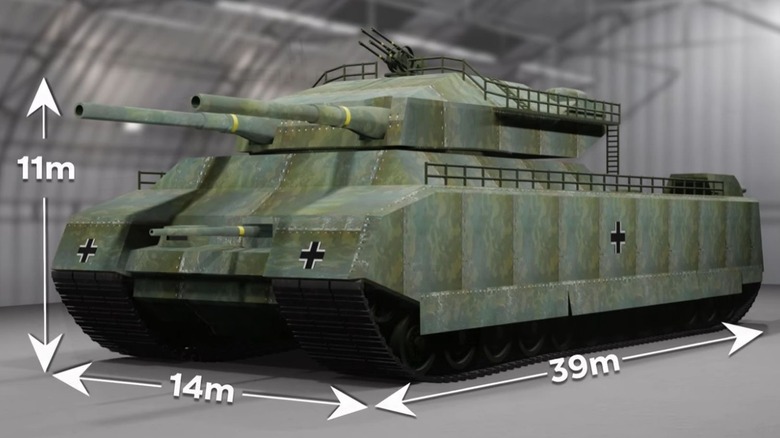Why The Krupp Landkreuzer P.1000 Ratte Tank Was One Of The Worst Designed By Germany
From the biggest gun ever used in combat to the terribly impractical massive Panzer VIII Maus, Hitler's maniacal quest to dominate the world resulted in some of the most bizarre instruments of war the world has ever seen. And the tank known as P.1000 during development, would have been no exception.
Thankfully, the Landkreuzer Ratte (as it has since come to be known) was never built. "Landkreuzer" means land cruiser in English, while "Ratte" (rat) was an ironic tongue-in-cheek gesture to its Maus forebear. The "P" stood for "Project," while the 1000 alluded to its overall weight, which was anything but mouse-sized.
Where the Panzer VIII Maus was impractical, the design and scope of the Landkreuzer were preposterously impossible. Impossible or not, the Ratte was one of the many "Wunderwaffe" super-weapons dreamt up by the Nazis during World War II. Wunderwaffe in German literally means "miracle weapon," "wonder weapon," and even "universal solution." They were good at propaganda.
This particular "wonder" was dreamt up by Edward Grote in June 1942, who at the time was the director of Krupp AG, one of Germany's leading steel and arms manufacturers. His last name is commonly misspelled with two "t's," but British and German patent filings show it spelled with only one.
Grote was also the man behind the dreaded Tiger tanks, but his design for the P.1000 wasn't original. Instead, it was based on the line of British land ships of World War I, which were basically just seafaring battleships with tracks.
The P.1000 was one big rat!
Dimensions for the Landkreuzer were jaw-dropping: 115 feet long, 46 feet wide, and 36 feet high. It would have weighed 1,000 tons, with as much as 300 tons worth of 10-inch armor plating. Had the Ratte come to life, it would have been five times heavier than the heaviest tank ever built, the previously mentioned Panzer VIII Maus (regarded as one of the worst tanks ever built).
Its big main guns were a pair of linked cannons (like those on the seafaring Scharnhorst-class battleships), mounted in a rotating turret that shot 280mm shells. But that's just the start. It would've also been fitted with a plethora of smaller guns and anti-aircraft weapons that dotted the chassis, covering every field of fire, including at least one 128mm gun, as many as eight 20mm anti-aircraft flak guns, and a pair of 15mm machine guns.
Moving the beast would have required eight Daimler-Benz 20-cylinder diesel marine engines, each producing 2,000 horsepower and weighing 37 tons. A total of six 69-foot-long treads (three on each side) were needed to move it along, using one liter of diesel every 20 seconds at full power. Not to mention, it took a crew of 40 men to operate. It was so massive, a full squad of reconnaissance motorcycles (typically consisting of 50 bikes) could sit inside its bay.
Ultimately, each Landkreuzer would have cost an estimated $1.4 million (in today's dollars) to build. After numerous iterations and changes to the plans, Albert Speer — Hitler's Reichsminister (Minister of Armaments and War Production) — cancelled the project in 1943 before a single prototype was built.
